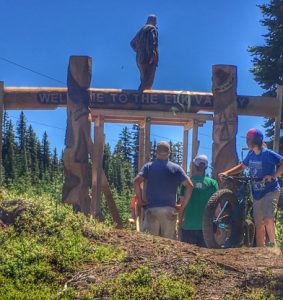This is the first part in a series featuring the value of a cohort-based approach to graduate education.
The Department of Leadership & Administration is celebrating the 40-year anniversary of our Master’s programs in Canada. For four decades, the department has formed cohorts of working educators in their locales, and applied course content and assignments in their professional settings. Graduates of our Master’s programs have consistently reported that the program changed their life.
Dr. Elaine Radmer spent the last two years advising a group in Fernie, British Columbia. The Fernie cohort perfectly highlights the value of Gonzaga’s site-based approach. “All but one of the educators were from a single school district, but that district spans a number of communities,” Dr. Radmer wrote. “Geographically, they are spread along a single highway, but it takes almost two hours to travel between the outermost cities.”
In many ways, the Fernie cohort is very typical for our programs. Their coursework structured for application in our students’ professional work, so at the end of their program, they have a list of accomplishments advanced by their involvement in the program. Graduates often tell us that the program modeled experiential education for them. Faculty think of it as Ignatian pedagogy.
Our latest Fernie cohort’s graduation year coincided with another celebration: Canada 150 (a provincial change to the curriculum structure. Their district responded to B.C.’s new curriculum by encouraging project-based learning. Inspired by the cohort’s collaboration, their instructors, and the program content, some of our candidates decided to facilitate students in a project that would memorialize Canada 150 and represent unity among different schools who typically only compete in sports. Thus, the Elk Valley Arch project came to realization.

The Elk Valley Arch. Shared from elkvalleyarch.com
One of the candidates in the cohort, Steve, envisioned and spearheaded this major inter-provincial project, involving four schools to design, build, and erect 14’ x 16’ cedar archway at the top of mountain pass on Alberta/B.C. border. The story and images of the 3,000 kg arch are on a student-launched website, which was part of the learning embedded in the project: https://elkvalleyarch.com/.
Preparation spanned 10 months. Steve wrote 10 grants, raising $23,000 for the project. He involved colleagues, administration, School Board, government officials and private business people. They were able to obtain permissions to build the structure on crown land leased by a hydro company.
Students in a number of classes at the different schools were involved in designing, creating and transporting the memorial. In Sparwood, Social Studies and Grade 5 students helped identify symbols of the valley. The metal shop built a cart to haul the massive logs up mountain. The Woods class worked on the scaffold. Foods classes prepared granola for students to eat while camping, etc…
Students also played leadership roles in Elkford. Students presented the concept to the Town Council, informed the media and newspaper, and sought out businesses and volunteers willing to support the project.
Seven staff from 3 different schools, 5 volunteers, and 20 students moved the wood up the mountain by hand, and then constructed the arch. Local media covered the Arch. Additionally, a group of students participated in a 3-day outdoor education program, camping on the mountain.
Leave a Reply